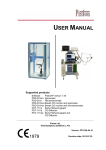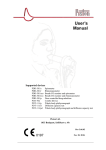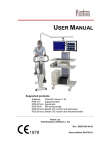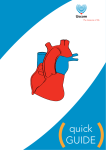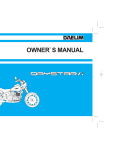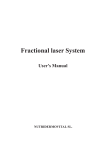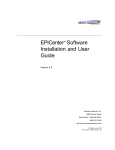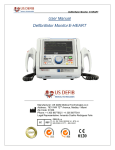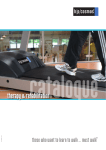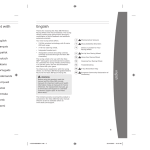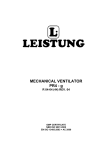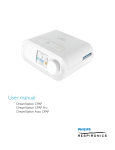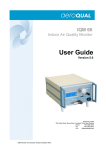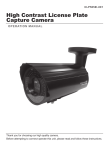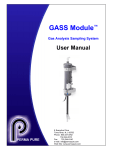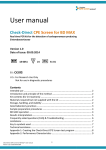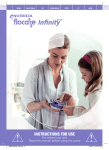Download - Piston Medical
Transcript
ES Ergospirometry Supported devices PRE-201 Ergospirometer Piston Ltd. 1033 Budapest, Szőlőkert u. 4/b Rev.: ES-EN-04.10 Date modified: 31/04/2014 T ABLE OF CONTENT Introduction ..........................................................................................................4 Devices ...............................................................................................................4 Technical overview ............................................................................................4 Installation.............................................................................................................6 PRE-201 Ergospirometer installation ...............................................................6 PRE-201 Ergospirometer patient circuit assemble ..........................................7 Ergospirometer placement.................................................................................9 Gas cylinder connection to the Ergospirometer .............................................10 User interface ..................................................................................................... 11 Settings .............................................................................................................11 Icons..................................................................................................................13 User interface - Ergospirometry......................................................................14 Calibration ......................................................................................................... 16 Flow meter calibration .....................................................................................16 Ergospirometer calibration ..............................................................................16 Measurements.................................................................................................... 18 Available examinations ...................................................................................18 Zero setting .......................................................................................................20 Preparations ......................................................................................................21 Interaction of the patient and medical devices ...............................................22 Evaluation of the cardiopulmonary test..........................................................24 Measurement modes ......................................................................................... 25 Ergospirometry.................................................................................................25 REE – Resting metabolic test..........................................................................38 Maintenance ....................................................................................................... 40 Device maintenance.........................................................................................40 Flow meter maintenance..................................................................................40 Ergospirometer maintenance...........................................................................41 Single-use parts ................................................................................................41 Reusable accessories........................................................................................41 Refill of the gas cylinders................................................................................42 Troubleshooting................................................................................................. 44 Possible problems ............................................................................................44 Technical data.................................................................................................... 45 Warranty ...........................................................................................................45 Limited liability................................................................................................45 Safety instructions............................................................................................45 Informing values ..............................................................................................46 Electrical data ...................................................................................................46 Mechanical data ...............................................................................................47 Guaranteed values ............................................................................................47 List of accessories ............................................................................................48 EMC Guidance and manufacturer’s declaration ........................................ 49 Introduction INTRODUCTION Devices PRE-201 Ergospirometer Measurement operating modes • Forced inspiration and expiration • Static vital capacity • Maximum voluntary ventilation • Resting ECG • Ergometry • Ergospirometry + EKG • Resting Energy Expenditure (REE) Design • Flow meter: PPF-18 PinkFlow, symmetric Pitot tube • Fast O2 and CO2 gas analyzer • USB computer connection • PC cart, 2 twin-monitor design • Isolation transformer (optional) • Calibration gas mixture: 16% O2 and 5% CO2 • Loading devices (optional): bicycle ergometer or treadmill Technical overview Lung diagnostic device family main parts description: Flow meter PPF-18 PinkFlow, symmetric Pitot tube flow meter, which provides pressure difference in proportion with the flow speed. A differentiate pressure sensor converts the pressure difference to electric signal. Patient circuit The patient circuit provides the connection between the patient and the equipment it consists of the following units: • • PinkFlow flow meter Facial mask and headgear Gas analyzer The patient’s exhaled has mixture must be sampled and analyzed to determine oxygen consumption and CO2 production. Elements of the gas calibration line • High pressure gas cylinder with the calibration gas mixture ES-4 Introduction • • • Pressure regulator Main valve Safety vale with pressure limitation Elements of the gas analysis: • Gas sampling capillary • PermaPure moisture exchange capillary to provide normalized humidity for the gas analyzers • Gas sampling pump • O2 and CO2 sensors Oxygen sensor • Chemical cell ultra fast oxygen sensor • Paramagnetic (non-depleting) oxygen sensor - optional Carbon dioxide sensor • NDIR (Non Dispersive Infra Red) fast gas analyzer Environment status measurement module PRE-201 BTPS correction requires the measurement of the following environmental data: • • • Environment temperature Environment relative humidity Atmospheric pressure Power supply PRE-201 Medical design switching power supply, which enables operating the device from any mains voltage: • • Mains voltage: 90~264 VAC Mains frequency: 50~60 Hz ES-5 Installation INSTALLATION PRE-201 Ergospirometer installation № 1 2 3 4 5 6 7 8 9 10 11 12 13 14 Colour Yellow Blue White Green Black White White White Red Description Gas sampling port Flow meter Flow meter LED indicating the data transfer Outlet of the calibration gas Intake port of the ambient air Mains socket Quick coupler of calibration gas Exhaust output of calibration gas Exhaust output of gas sample USB port of the Ergospirometer Intake port of the CO2 absorber Connection Patient circuit yellow connector Patient circuit blue connector Patient circuit white connector Quick coupler of gas sampling line Never block! Mains cable High pressure hose of gas cylinder Never block! Never block! USB cable to the PC Red connector of the CO2 absorber container Oxygen sensor holder CO2 absorber container ES-6 Installation Connect the power and data cables and the pneumatic connectors of the patient circuit to the device according to the different connector types and colour codes! PRE-201 Ergospirometer patient circuit assemble Push the device into the mounting frame Front panel pneumatic connectors must be located at the bottom The device should overhang on both sides equally Fasten the device using a 3 mm hex key ES-7 Installation Connect the flow meter docker to a clean PinkFlow flow meter. Push the metal release button to remove the PinkFlow flow meter from the docker. Button the white adapter ring up the facial mask Button the headgear buckle up the facial mask Connect facial mask to the headgear Push the smaller diameter side of the PinkFlow flow meter into the white adapter ring ES-8 Installation Ergospirometer placement There are numerous criteria of the ergospirometer placement: Environmental requirements: • The equipment can be used only in a well ventilated laboratory. If the laboratory has no natural ventilation for example there is no any open able window the equipment can be used only where an air exchanger installed and it guarantees open air quality of the internal air. O2 concentration: 20.93% CO2 maximal concentration: 400 ppm (STPD) • Avoid one meter proximity of any heat or cold radiating objects, like heating, cooling, window etc. • Provide stable temperature in the laboratory avoid any fast change of the temperature. Safety requirements All conditions of the resuscitation have to be provided both human and material ones: • • • Cardiologist and professional assistant Defibrillator Treatment bed in one meter proximity Conformity feeling of the patient • The patient has to be far from the outlet of the air-conditioning avoiding any air drafts since the patient’s body overheats because of the exercise and could catch a cold easily. • Locker and shower • Relax room ES-9 Installation Gas cylinder connection to the Ergospirometer Place the gas cylinder to the PC cart and fasten it with the belt Regularly change the sealing ring of the gas cylinder Connect the pressure regulator to the gas cylinder Plug the high pressure hose to the pneumatic connector of the gas cylinder Fasten the high pressure hose using the fitting nut Open the main valve of the gas cylinder and set the secondary pressure to 1 bar Caution! As the gas calibration is completed always close the main valve of the gas cylinder ES-10 User interface USER INTERFACE Settings Ergospirometer Select the Ergospirometer group in the Setup/Options/Devices menu Bicycle ergometer Selection of the bicycle ergometer type if any connected Treadmill Selection of the treadmill type if any connected Blood Pressure monitor Available options: • • • Manual BP measurement Ergometer type – if the loading device has a built-in blood pressure meter Selection of any other standalone blood pressure meter if any connected Fitness interpretation Fitness interpretation evaluation is based on the maximal oxygen consumption. There are two algorithms to select: • • American Heart Association, 1972 Cooper Institute for Aerobics Research, 1997 BMR prediction Basal Metabolic Rate. There are two algorithms for calculation of reference value of the reseting metabolic rate: • • Mifflin - St Jeor Equation, 1990 Harris - Benedict Equation, 1919 O2 concentration Oxygen concentration specified in the certificate of the gas refilling company CO2 concentration Carbon dioxide concentration specified in the certificate of the gas refilling company Use filter for VO2 and VCO2Use filter for VO2 and VCO2 Enabling the averaging filters for VO2 and VCO2 calculations. It is advisable to enable these filter during Steady state and Mixing chamber measurements. FVC loop on main screen The median value of breathing can be monitored on the FVC panel. This graph can be moved into the main window to substitute the spirogram. ES-11 User interface Parameter columns The number of columns of the displayed parameters during the measurement can be specified. Log time interval Time interval of the registration into the log file Mixing Chamber Select this option if a Mixing chamber is in use Bicycle Port setup... Treadmill Port setup... BP monitor Port setup... Settings of the communication ports of different connected devices Select the appropriate PC port where the loading equipment is connected All the other settings should be set according to the specification of the loading equipment. Some settings will be automatically overridden according to the selected loading equipment. Bicycle Ergometer and treadmill protocols Editing and modifying protocols are possible in the Ergospirometry measuring window. The detailed description can be found in the Ergospirometry chapter. ES-12 User interface Icons Ergospirometry Settings Protocol editor Predicted values and results Actual test Breath median Diary Test interpretation, Wasserman graphs Templates – Enter new item Templates – Edit items Templates – Store edited item Templates – Delete selected item Templates – Abandon modifications ES-13 User interface User interface - Ergospirometry The following image shows the general design of the measurement screen. The individual measurement windows may different from each other but the main controls are identical. Device selector Zero setting Menu Navigator Patient data BTPS data Complex curves Spirogram Timer Parameters Control Device selector Select the device to be used from the drop down list. This is necessary if, for example, you own a Plethysmograph and a Spirometer, and would like to perform IVC measurement. Zero setting Runs manual Zero setting of the selected device Without manual Zero setting the system automatically sets zero before all measurements Menu The program’s general main menu, which contains the grouped basic functions. Navigator Control buttons which organise the basic phases of daily routine. Patient data Contains the most important measurement data for the patient selected from the database. ES-14 User interface BTPS data Usually our ergospirometer is equipped with the ambient module which measures the ambient temperature, humidity and pressure. These ambient data are shown in BTPS fields. If there is no ambient module connected you may enter the ambient data manually Overview histrogram Graphical interpretation of the most iprotant parameters like: VO2, VCO2, VE, Load, Heart rate, Blodd pressure, Saturation Spirogram Volume-time graph which monitors the breathing of the patient Timer May show the duration of the total test or the duration of the individual load steps or countdowns the time Control These control buttons organise basic phases of daily routine as follws: • • • • • Start monitoring [F3] Start measurement, beginning of the protocol [F4] Cooling down phase End of measurement [F5] Store and print ES-15 Calibration CALIBRATION After turning the device on and entering the BTPS data, calibration is recommended for maximum measurement accuracy. Calibration is recommended when starting a new shift, after flow sensor disinfections or replacement. IMPORTANT If work environment conditions (temperature, air pressure, humidity) change significantly, re-calibration is recommended! Flow meter calibration Please make the calibration of the flow meter according to the “Spirometry” volume of this manual. Ergospirometer calibration Ergospirometer calibration is performed in the Spirometry/Calibration menu. IMPORTANT Before calibration, the room has to be ventilated to reduce carbon dioxide concentration! Never breathe directly onto the device during calibration! Exhaled carbon dioxide will corrupt calibration results. In case of several connected devices, select Ergospirometer from the [Device selection] list. Prior to the calibration of the gas analyzers make the following steps: • • • Open the main valve of the gas cylinder Check the secondary pressure the nominal value is 1 bar Disconnect the gas sampling line from the PinkFlow docker and connect it to the Calibration gas output on the device The gas sampling line has a quick action connector. For release the grey button has to be pushed and for connection it is enough to push till clicks Determining ambient carbon dioxide concentration To measure ambient carbon dioxide concentration, select the Setup tab and click the button [Measure CO2 ppm]. The measurement is performed automatically. ES-16 Calibration Calibration of gas analyzers The calibration of the gas analyzers is done automatically in the background during the zeroing of the flow channel. Possible error messages Calibration Error 1: Gas plug not connected! In this case the connections of gas sampling line has to be checked. Calibration Error 2: Calibration constant out of range! Calibration Error 3: Oxygen sensor used up! If the calibration is not accepted by the system repeat the whole procedure. If the error message appears again contact your local dealer. Calibration Error 4: Room's air used up. Ventilate it as well as possible! Thoroughly ventilate the laboratory and repeat the whole calibration procedure. ES-17 Measurements MEASUREMENTS Available examinations The ergospirometer system provides the following basic lung function tests: • • • Forced exhalation and inhalation Static vital capacity Hyperventilation For detailed description please refer to the “Spirometry” volume of this manual. Ergospirometry Cardiopulmonary exercise testing provides a global assessment of the integrative exercise responses involving the pulmonary and cardiovascular system. Detailed information may be found in the Measurement modes chapter. Safety precautions • The Ergospirometer can be used only by a trained and authorized personnel • A cardiologist has to supervise the whole exercise test procedure • Prior to the exercise test always get know the detailed anamnesis of the patient • The personal and the material conditions of the resuscitations has to be provided In this operating mode the device measures the following parameters: V Actual inspiration volume VT Tidal volume during quiet breathing VE Total volume of the breathing during one minute Volume Tidal Volume Minute ventilation Load Actual load setting of the bike ergometer Load Calculated load of the treadmill based on the oxygen consumption RPM Actual pedal revolution of the bike ergometer BPsys, BPdia Last values of the blood pressure HR Actual heart rate Pedal revolutions Blood pressure Heart rate ES-18 Measurements HRR Residual pulse Difference of the maximal predicted heart rate based on the age and the actual heart rate HR% Percentage of the heart rate Percentage of the actual heart rate to the maximal predicted heart rate based on the age SpO2 Oxygen saturation of the blood pO2 Momentary oxygen concentration Saturation Momentary O2 concentration pCO2 Momentary CO2 concentration Momentary carbon dioxide concentration VO2 Momentary oxygen consumption, ml/m Momentary O2 consumption VCO2 Momentary CO2 production Momentary carbon dioxide production, ml/m PETO2 O2 concentration at the end of expiration Oxygen concentration at the end of expiration PETCO2 CO2 concentration at the end of expiration Carbon dioxide concentration at the end of expiration VE/VO2 Minute ventilation / O2 consumption Ratio of the minute ventilation and the momentary oxygen consumption VE/VCO2 Minute ventilation / CO2 production Ratio of the minute ventilation and the momentary carbon dioxide production VO2max Maximal O2 consumption Maximal oxygen consumption during the whole test VCO2max Maximal CO2 production Maximal carbon dioxide production during the whole test VO2/HR Oxygen delivery by one heart beat Oxygen/pulse BPsys×HR Product of systolic blood pressure and heart rate Product of systolic blood pressure and heart rate BR Breath rate, breath / minute Breath rate RER Respiratory Exchange Ratio Ration of the CO2 production and O2 consumption during exercise RQ Respiratory Quotient Ration of the CO2 production and O2 consumption during resting VO2/kg Ratio of momentary O2 consumption and body weight Momentary O2 consumption / body weight, ml/m/kg VCO2/kg Ratio of momentary CO2 production and body weight Momentary CO2 production / body weight, ml/m/kg ES-19 Measurements Work Carried out work Total carried out work during the whole exercise, kCal MET Metabolic Equivalent Energy request of the physical activity. Base unit is the resting energy request of the person being tested. It is a calculated value based on the VO2. METc Calculated Metabolic Equivalent Energy request of the physical activity. Base unit is the resting energy request of the person being tested. It is a calculated value based on the body weight and load. Speed Speed of the treadmill If the loading device is a treadmill the speed of the treadmill. If the loading device is an ergometer bike this parameter is calculated from the oxygen consumption. Grade Elevation angle of the treadmill If the loading device is a treadmill this parameter is the elevation angle of the treadmill REE Resting Energy Expenditure Resting energy expenditure in kCal / day. This parameter is calculated from the O2 consumption and CO2 production. Zero setting For exact volume measurement the zero setting of flow meter channel must be performed immediately before the measurement. In case of Ergospirometer pneumatic valves detach the flow meter from the pressure transducer, so zero setting occurs automatically in the background. Patient may continue breathing thru the flow meter. Zero setting process The program automatically starts the zero setting process immediately before each measurement. The system evaluates the data measured during the zero setting process, and displays an error message and repeats the zero setting process if a zero error is encountered. Manual zero setting You can reset the currently selected device anytime with the [Zero] button next to the [Device selection] list in the program header. Notice Zero setting is automatically performed before calibration. ES-20 Measurements Preparations Device Patient circuit To prevent cross contamination a new disposable bacterial and viral filter must be connected before each patient measurement. Patient Recommended body position • Sitting on a chair • Straight back • Level head • Tight clothing or jewels must not prevent free breathing Directions Prior to the tests inform the patient about the goal and way of the measurements. For detailed description please refer to the “Spirometry” volume of this manual. Ergospirometry preparations The cardio-pulmonary exercise test fully differs from the usual pulmonary function tests. It requests not only co-operation but mental and physical abilities from the patient as well. In order to reach the best results the patient has to be aware of the special aspects of the exercise test in advance. • • • • • • • • • The exercise test physically strenuous The exercise test has certain level of risk Sport dress and shoes are advisable The patient has to avoid eating before the exercise test by a few hours The patient has to avoid eating heavy and fatty meal before the exercise test by a few days The patient has to avoid any heavy physical activity before the exercise test by a few days The patient has to avoid smoking before the exercise test by at least 8 hours Prior the exercise test a full anamnesis has to be recorded including regular medical treatment, medicines applied especially the cardio pulmonary aspects The total duration of a complex exercise test including the preparation, dressing and evaluation is about one and half an hour Resting metabolic test preparations The relaxed metabolic test is for analyzing long duration processes therefore the patient has to be aware of the special aspects of the test well before. ES-21 Measurements • The patient has to avoid any heavy physical activity before the exercise test by a 48 hours • The patient has to avoid eating and drinking before the exercise test by a 4 hours, of course water drinking is allowed • The patient has to have a loose and comfortable dress which provide comfortable temperature feeling • The patient lays down and relaxes for 20 – 30minutes • The total duration of the test is about one hour If any of the above listed criteria is not fulfilled there is no sense to make the exercise test Interaction of the patient and medical devices The proper usage of the consumable parts is necessary to reach the most correct measurements. Nose clip Apply nose clip during all pulmonary function tests expect for the tests done in facial mask in order to avoid false breathing thru the nostrils. Mouthpieces The mouthpiece provides the proper connection between the patient and the device. MPA-30 – Simple mouthpiece Elliptic mouthpiece is for the basic pulmonary function tests PMP-30 – Mouthpiece with bite-on grip For the more demanding pulmonary function tests where the proper sealing is even more important like body plethysmograph or diffusion capacity test PBF-100-G-M Bacterial and viral filer with elliptic patient side for the basic pulmonary function tests Facial masks Applying facial masks makes possible the oral and nasal breathing simultaneously. It provides more comfort and requests less co-operation. Facial masks are used mostly for ergospirometry and for rhinomanometry. • • Select the best fitting size for the patient the full and proper sealing has to be reached Assemble the adapter ring and the headgear ES-22 Measurements • • • • • • Place the facial mask to the patient’s face as show non the picture Adjust the length of the belts of the headgear Fasten the headgear with the Velcro tapes Never push the facial mask too strong against the patient’s face To check the proper sealing the patient has to block the orifice of the mask with hand and has to make ex- and inspiration efforts. No leakage is allowed at all! If necessary select an other size of the facial masks If the patient is not fully shaved some leakage may occur. In this case the facial hair has to be shaved. Blood pressure meter A lot of different blood pressure meter can be integrated into the ergospirometer system. Always follow the regulations of the user’s manual of the given blood pressure meter. Take care that the built-in microphone of the handcuff has to be in the position over the Arteria Brachialis! ECG A lot of different ECG can be integrated into the ergospirometer system. Always follow the regulations of the user’s manual of the given ECG device. Bicycle ergometer The body position may influence the maximal working capacity of the patient. Further more the height of the saddle determines which the muscles groups will be used. In the case of healthy patient The ideal height of the saddle is when the patient with a stretched leg may reach the pedals with the heel. The patient has to push the pedals with the middle of the sole pads. Elderly and patient moving with difficultness Adjust the height of the saddle to reach the most comfortable and the most sense of security for the patient. Athlete Athletes are mostly coming for the exercise tests to reach their limits so the usual position is important for them. Athletes may adjust the bicycle ergometer themselves the height and position of the saddle and the hand bar. Right position of the foot The ideal position of the feet is when the middle of the sole pads are on the pedals. ES-23 Measurements However in the case of elderly and patient pushing the pedals with the full sole is allowed. Treadmill Treadmill can be applied for all ambulatory patients but there are a number of safety precautions. Read carefully the user’s manual of the treadmill integrated into the system. • • • • • • Never allow to use treadmill in a dress which may have loose part like robe belt or too long trousers because these loose part can be cached by the rollers! Never touch the moving parts of the treadmill like rollers or the height adjusting mechanism! Never stand on the belt barefoot! Use always training shoes! Use always the safety belt which stops the treadmill immediately as the patient is not able to keep the speed! Never try to block or override the safety system of the treadmill! Evaluation of the cardiopulmonary test During ergospirometry only one test can be performed in contrary with the basic pulmonary function tests when 8 tests can be performed simultaneously. Evaluation of the cardiopulmonary test is described in the next chapter. ES-24 Measurement modes MEASUREMENT MODES Ergospirometry WARNING! The whole ergometer test has to be supervised by a cardiologist The detailed anamnesis has to be reordered prior to ergospirometer test The ergospirometer test can be performed if all the conditions of the resuscitation are provided Goal of the test Cardiopulmonary exercise testing provides a global assessment of the integrative exercise responses involving the pulmonary and cardiovascular system. Ergospirometry is increasingly being used in a wide spectrum of clinical applications for the evaluation of undiagnosed exercise intolerance and exercise-related symptoms HR, BP, SpO2 Main window panel Manual trol con- Spirogram Parameter table ES-25 Measurement modes The ergospirometer test is a rather complex measurement consequently it requests two monitors. According to the conventions the left monitor is for the ECG and right monitor is for the control and for the monitoring all vital parameters. Since different models of ECG devices can be integrated into our ergospirometer system this chapter describes the right monitor in majority. HR, BP, SpO2 panel The main cardiologic parameters are displayed in this panel during the test Main window The main pulmonary and metabolic parameters are displayed during the test: VO2, VCO2, VE Manual control The load rate of the bicycle ergometer or the speed and angle of the treadmill can be modified at any time during the whole test In the case of bicycle ergometer the automatic protocol is not aborted by the manual modification only the actual load rate is increased by the Increase value. In the case of treadmill the automatic protocol is not modified by the manual modification the next load steps equals to value preset in the protocol. Spirogram The breathing is monitored in this window the tidal volume, frequency and the median of breathing can be observed. Parameter table The values of the main vital parameters are shown during the test. Load equipment Press the [Protocol] tab and in the [Ergometer type] section select the load equipment to use: • • • Bicycle ergometer Treadmill Tidal test The panel of protocol settings is automatically changes according to the selected load equipment. The detailed description of the Resting Metabolic Test can be found in the Tidal test az REE – Resting metabolic test chapter (38. page). ES-26 Measurement modes Handling templates Configurations and settings of the exercise tests can be stored in templates in the following groups: • • • • Bicycle protocols Treadmill protocols Measurements of blood pressure Limits Creating a new template Press the „New template” button • • Give a name to the new template Enter values in to the fields Editing existing template Press the „Edit template” button Delete a template Press the ’Delete template” button Store After definition of a new template or modification of an existing template: • Push the „Store modifications” button to store modifications • Push the „Abandon modifications” button to cancel modifications Bicycle ergometer protocols The loading protocols are increasing the load rate from the basic value by a given step in certain time intervals. Practically the protocol is a Load(Time) function. Afterwards the loading is followed by the cooling down phases. Load configuration Initial value: The starting load rate of the test Increase: Increase of the load between two steps Manual increase: Step of the manual modification. During the manual control of the load this value will be added to the actual load rate. The ES-27 Measurement modes manual modification does not abort the automatic protocols the Increase value is always added to the actual load rate. Step length: The load rate is increased by the specified time interval independently of the manual control Recovery First phase - load: The first cooling down phase starts with the specified load rate First phase - length: Duration of the first cooling down phase Load: The second cooling down phase starts with the specified load rate Length: Duration of the second cooling down phase Ramp protocol (continuous increase of load) The load rate is increased continuously during the test. The load rate readjusted in every second accordingly to the load rate resolution of the loading equipment. In this case the load rate is increased by the [Increase] value in the every [Step length]. Example: If the Step length = 60 sec and the Increase = 15 Watt further more the load rate resolution of the bicycle ergometer is 1 Watt it means that the load rate will be increased by 1 Watt in every 4 seconds. Treadmill protocols Usually treadmill protocols are defined in tables and the load rate is specified step by step. The number of protocols is unlimited and there are numerous factory preset protocols to select. ES-28 Measurement modes Factory preset protocols • Bruce • Bruce Mod • Blake • Blake Mod • Naughton • Cornell • ACIP • Ellestad I. and II. Manual control Manual increase of speed: The speed can be increased or decreased by the specified step. Manual increase of grade: The slope can be increased by the specified step. The system may override the actual settings according to the resolution of the actual treadmill. For example an 0.1% increase can be rounded to the smallest accepted value as 0.5% or 1%. Manual modification does not influence the automatic protocol the next load step will be set according to the preset values. Setting of particular steps Time: Duration of one step in seconds Speed: Speed in kilometre per hour Grade: Slope of the treadmill in percent (For example 5% slope means 5 meters difference of level in 100 meters) Blood pressure measurement Individual blood pressure measuring profile can be defined for each loading equipment and for each loading protocol. For example if the system is equipped with a bicycle ergometer and with a treadmill as well further more a ramp protocol is used for the bicycle ergometer and the Bruce protocol is used for the treadmill. While using the bicycle ergometer the blood pressure will be measured by the built-in blood pressure meter of the bicycle automatically in every 2 minutes. While using the treadmill a warning signal for manual blood pressure measurement will be generated in the 3. minute of the each step of the protocol. ES-29 Measurement modes Manual BP measurement: The blood pressure is measured manually the system does not control any automatic blood pressure meter. A warning signal is generated when the blood pressure measurement is necessary. Blood Pressure measurement is actual Measuring period • Independent interval: The blood pressure measurements are done in predefined intervals calculated from the beginning of the test. It is independent of the actually running protocol. • Relative to the current step: The blood pressure measurement starts in a predefined time interval calculated from the beginning of the actual load rate step. Limitations The time interval defined blood pressure measurement can be used at the following conditions: • • • This feature is not available for the ramp protocols because there are no definitive start points of the different load rates. In this case the [Independent interval] option has to be selected. The duration of the load step has to be longer then specified delay time The cycle time of a automatic blood pressure measurement has to be taken into consideration (30÷60 sec) when editing a load protocol and a blood pressure measurement profile Ignore failed measurements If a blood pressure measurement is unsuccessful only a warning message appears. Limits During the exercise test some vital parameters may reach critical limits which could be risky for the patient. These limits are partly published by the international recommendations and partly they are determined individually for each patient. Obviously these limits are sharply different for a healthy person or for an ill patient (transplanted or with a pacemaker) or for a professional athlete. If monitoring of a certain parameter is not necessary enter 0 value and monitoring of that parameter will be suspended. ES-30 Measurement modes It is impossible to suspend the monitoring of maximal heart rate. If the filed value is empty the maximal heart rate is calculated from the well known equation: Maximal heart rate = 220 - Age Contraindications According to the ATS/ACCP Statement on Cardiopulmonary Exercise Testing (March 1, 2002) making an exercise test is severely contraindicated upon the following circumstances: Absolute contraindications • Acute myocardial infarction (3–5 days) • Unstable angina • Uncontrolled arrhythmias causing symptoms or hemodynamic compromise) • Syncope • Active endocarditis • Acute myocarditis or pericarditis • Symptomatic severe aortic stenosis • Uncontrolled heart failure • Acute pulmonary embolus or pulmonary infarction • Thrombosis of lower extremities • Suspected dissecting aneurysm • Uncontrolled asthma • Pulmonary edema • Room air desaturation at rest < 85%* • Respiratory failure • Acute noncardiopulmonary disorder that may affect exercise performance or be aggravated by exercise (i.e. infection, renal failure, thyrotoxicosis) • Mental impairment leading to inability to cooperate Relative contraindications • Left main coronary stenosis or its equivalent • Moderate stenotic valvular heart disease • Severe untreated arterial hypertension at rest (>200 mm Hg systolic, >120 mm Hg diastolic) • Tachyarrhythmias or bradyarrhythmias • High-degree atrioventricular block • Hypertrophic cardiomyopathy • Significant pulmonary hypertension • Advanced or complicated pregnancy • Electrolyte abnormalities • Orthopedic impairment that compromises exercise performance ES-31 Measurement modes ATTENTION! The list of contraindications is only for information purposes the whole responsibility of the exercise test belongs to the supervising physician! Indications of stopping of an exercise test It is advisable to stop an exercise test when any of the following symptoms or phenomenon occurs: Absolute reasons of stopping • The systolic blood pressure decreases by more than ≥10 Hgmm during increasing load rate and there are other symptoms of the myocardium ischemia. • Middle or even more serious level of angina pectoris • Symptoms of central nerves system (ataxia, dizziness, threaten syncope) • Symptoms of the Hypo perfusion (considerable paleness, cyanosis) • Sustained tachycardia of chambers (≥30 s) • ST elevation is ≥1 mm at the lead where is no pathologic Q wave • The continuous monitoring of ECG and of the blood pressure for any reasons is interrupted • The patient claims for finishing Indications of relative stopping • The systolic blood pressure decreases by more than ≥10 Hgmm during increasing load rate • Appearance of considerable ST depression (>2 mm horizontal or „down sloping”) or a quick change of the QRS axle • Exhaust, choking, asthmatic breathing, pain in the legs • Increasing chest pain • Pathologic response of tension (systolic RR >250 Hgmm, diastolic RR 115 Hgmm) Attention! The list of possible reason for abortion is only for information purposes the whole responsibility of the exercise test belongs to supervising physician! Preparation It is necessary to inform the patient about the process of the measurement. Application of different sensors is described in the chapter “Interaction of the patient and medical devices” • • • Make sure that the patient obeyed all the regulations which prescribed during the preliminary information concerning eating, smoking, physical activity Go through the anamnesis again According to the existing legal regulations ask the patient to sign the declaration of content for the exercise test ES-32 Measurement modes • • • • • • • • • • • The patient has to change the dress In the meanwhile the calibration procedure has to be done Make the basic pulmonary function tests (FVC, MVV) Attach the self adhesive ECG electrodes to the body of the patient Check out the user’s manual of the currently applied ECG equipment as well. In the case of an ergometer bicycle ask the patient to seat on the saddle. In the case of the treadmill ask the patient to stand on the equipment as all the sensors are attached. Connect the cables to the electrodes. Pay attention to the free movement of the patient. Cables should not touch any limbs of the patient during the exercise. Attach the hand cuff of the blood pressure meter Call attention of the patient that speaking is prohibited during the exercise test because it could influence the measurement Teach a simple sign language to the patient, use the Borg scale. Patient may reply with a nodding to the simple questions as: „ Are you all right?” or „Are you able to proceed?” etc. Attach the facial mask to the patient with the supplied head gear Predicted values The system calculates the following predicted values according to the recommendations of the Karlman Wasserman: • • • • Maximal hear rate (HR max) = 220 - Age Expected load calculated on the base of the body surface and weight Maximal oxygen consumption (VO2max) (VO2/HR) max = VO2 max / HR max ES-33 Measurement modes Measurement process There is a possibility for monitoring all vital signs of the patient before the exercise test. In the similar way there is a possibility for monitoring all vital signs of the patient after cooling down phases for any duration. All vital parameters are stored and both ECG signals and pulmonary signals can be retrieved and analysed later. • • • • • • • • • • • • To start the ECG monitoring push the [ECG] button To start the pulmonary monitoring push the [Monitor] button The patient needs about 1-2 minutes to get accustomed to the sensors and to the facial mask. Similarly the systems needs the same period of time to calculate the resting medians of the parameters. Usually protocols prescribes 3 minutes of resting monitoring but it can be overridden according to the status of the patient or any other actual needs If the manual blood pressure measurement was selected pushing the [F6] button will activate the entry fields of blood pressure. As the systolic and diastolic value was entered push the [Enter] button To start the protocol push the [Start] button Supervise all the vital parameters of the patient continuously. If there is any sign of disturbance act according the to the Indications of stopping of an exercise test chapter. If the patient reached the maximal load rate push the [Recovery] button to start the cooling down phase monitoring is still sustained. End of the cooling down phase is indicated further more the load of the bicycle ergometer is decreased to the minimal or the treadmill stops. The load rate, the speed and the slope still can be modified manually If the patient got relaxed and all vital parameters returned close to the normal resting level push the [Done] button to finish monitoring Evaluation of the exercise test can be done while the patient is relaxing Function buttons during the test Start monitoring F3 Start protocol F4 ECG monitor: ST amplitude on/off F5 Manual entry of blood pressure values F6 Swap to the main screen F8 Swap to the Wasserman panels F9 Cooling down phase ESC ES-34 Measurement modes Evaluation of the exercise test Interpretation and evaluation of the exercise test is done according to the recommendations of Karlman Wasserman. • Click on the Wasserman tab Marker Wasserman panels Monitor window All parameters Close panel As the exercise test is completed the system determines anaerobe threshold automatically by four different algorithms: • • • • RER = 1 V-Slope VCO2/VO2 VE/VCO2 Equivalent VE/VO2 Equivalent Anaerobe thresholds calculated by the system are only for informational purposes they can be adjusted manually. The final anaerobe thresholds have to be determined in an empiric way by physician. ES-35 Measurement modes RER = 1 This algorithm determines the anaerobe threshold at that point where the VCO2 exceeds the VO2 or with other words the ratio of them exceeds the 1.00 value for the first time. Click on the [Gas Exchange] graph Modify the counter up/down to reach the desired position Or push the [Manual correction] button and move the cursor on the graph manually V-Slope This algorithm determines the anaerobe threshold at the significant breaking point visible on the VCO2(VO2) graph. Click on the [HR, VCO2/VO2] graph Push the [Aerob] or the [Anaerob] button Match the marker with the selected part of the curve with the help of the mouse VE/VCO2 equivalent This algorithm determines the anaerobe threshold at the significant breaking point visible on the VE(VCO2) graph. Click on the [VE/VCO2 ekvivalens] graph Push the [Aerob] or the [Anaerob] button Match the marker with the selected part of the curve with the help of the mouse VE/VO2 equivalent This algorithm searches for a point where • • • the VE/VO2 started already to increase the VE/VCO2 is not increasing yet the pCO2 is not decreasing yet Click on the [Equivalents] graph Modify the counter up/down to reach the desired position Or push on the [EQO2] or [EQO2] button and move the marker on the graph with the help of the mouse ES-36 Measurement modes Result overview As the AT (anaerobe threshold) is determined already push the [Result] tab the overview of the results will be shown in a table divided by the different phases: • • • Resting phase Anaerobe threshold Peak values Values of each parameter are shown in a following sequence: • • • • Reference (predicted) value Maximal value, Ratio to the body weight, Ratio to the reference value Value at the AT, Ratio of the value at the AT to the body weight, Ratio of the value at the AT to the maximal value Resting value, Ratio of the resting value to the body weight, Ratio of resting value to the maximal value, Ratio of the resting value to the value at AT. Interpretation The system evaluates the fitness level of the patient taking into consideration the gender and age of the patient and the maximal VO2. This way of automatic interpretation is most useful in the case healthy and active persons. Store If all parameters seem to be correct push the [Store] button to store results The following data will be stored: • • • • ECG signals for the total duration of the test The measured vital parameters (HR, BP, VO2, VCO2 etc.) in time sequence continuously Flow and gas concentrations for the total duration of the tests The selected AT values and the relevant marker positions ES-37 Measurement modes REE – Resting metabolic test Measurement goal The goal of the test is the determination of the Resting Energy Expenditure (REE). The Basal Metabolic Rate (BMR) is the energy expenditure which is needed to supply the basic vegetative functions of a resting but awaken person. The Basal Metabolic Rate is estimated by the system and this value is taken as a Reference value. The values of the REE and of the BMR are very close to each other the difference between them is less than 10%. The main difference between them is the method how to measure them. The REE is determined after a 20 ÷ 30 minute resting during a 5 minute long period when the oxygen consumption and the carbon dioxide production are nearly constant. The BMR is measured right away after waking up at severe conditions, exactly on the same way as the REE measurement. HR, BP, SpO2 Main window panel Spirogram Timer Parameter table ES-38 Measurement modes HR, BP, SpO2 panel The basic cardiologic parameters are monitored during the whole test Main window The most important metabolic and breathing parameters are monitored: VO2, VCO2, VE Spirogram The spirogram shows the breathing, tidal volume, breath rate, and the shifting of the breathing median Timer The upper counter shows the total duration of the test and the lower counter shows the duration of the steady state Parameter table Values of the vital parameters are shown during the whole test. Preparation It is inevitable to inform the patient as described in the in the chapter Preparations. The following steps should be done: • Lay the patient down to the examination bed • The patient has to find a position whish is comfortable enough to lay without any movement for an hour • While the patient is laying down make the calibration of the system • Put the facial mask on the patient Measurement process • Select under the [Protocol] tab in the [Ergometer type] section the [Tidal test] option • To start the test push the [Monitor] button • The patient has to refrain from any movement and from speaking as well. Usually 20 ÷ 30 minutes are requested to reach the stable metabolic level. • Push the [Start] button as the VO2, VCO2, VE, RER parameters are getting stable • The system indicates the stable intervals by frames. The REE value is updated continuously. If all the conditions are met in a 5 minute interval the system indicates it: Steady state criteria met. • Push the [Done] button • Results are shown at the [Result] tab ES-39 Maintenance MAINTENANCE Device maintenance Our lung diagnostics devices do not require special maintenance. For continuous reliable operation take care of the following: • • • • • To prevent device contamination and patient cross-contamination after each test disinfect the flow meter, the facial mask and the headgear or change the bacterial and viral filter after the basic lung function tests The flow sensor must be contamination free The filter elements must be replaced according to instructions The PermaPure moisture exchange capillary must be replaced according to instructions The tubes must always be dry and cannot be broken Flow meter maintenance The flow meter condition and cleanliness affects measurement accuracy. Cleaning measurement head main parts The individual patient circuit type installations are described in section Installation. The plastic parts may be disinfected with cold water and appropriate chemicals (for example, Sekusept), and may be used after rinsing and drying. WARNING! • PermaPure moisture exchange capillary must be kept always dry. Do not clean it with water or any alcohol containing cleaning agent. • When the system is turned on never use any alcohol containing cleaning agent because it may penetrate into the gas analyzer line and could endanger the sensitive gas analyzers. The system can be turned on again only after the total drying and ventilaton of the laboratory. Cleaning the pneumatic twin-tubes • • • • Disconnect the twin-tube from the device and the flow meter Rinse the tube Do not clean the gas sampling capillary with any kind of liquid! After it is completely dried, reconnect the tube ES-40 Maintenance Ergospirometer maintenance Oxygen sensor The expected lifetime of the electrochemical cell is 2 years. As the oxygen sensor is getting older its sensitivity is decreasing. When it reaches the critical limit the next warning appears: Calibration Error 3: Oxygen sensor used up! Please contact your local dealer for changing the oxygen sensor Carbon dioxide sensor It is advisable to check the linearity of the sensor annually. If it is needed a new linearization has to be done. Please contact your local dealer for the linearization issue Load equipment maintenance Technical maintenance According to the Users manual the regular maintenance has to be done like cleaning and lubrication. Please contact your local dealer for the more complex maintenance Disinfection Those parts of the bike ergometer and of the treadmills which are in direct contact with the patients (seat, handlebar, and handrail) have to be disinfected regularly. Please follow the regulations of the manufacturers of the given load equipment. Single-use parts The basic lung function tests can be done with the single-use parts as well as described in the “Spirometry” volume of this manual. Reusable accessories Facial mask (AM-41280 series and HR-669170) The silicone facial masks can be disinfected in a cold disinfecting solvent (Glutaraldehyde, Sekusept, Cidex etc.). Rinse it carefully and dry fully before use. The average lifetime of the facial masks guaranteed by the manufacturer 6 months or 25 disinfecting cycles. ES-41 Maintenance Siez / HR-699170 series A C A B Size L M S XS Pediatric A [cm] 15.0 14.0 13.2 12.2 11.7 B [cm] 8.6 7.9 7.1 6.9 6.4 C [cm] 10.7 10.7 10.2 9.9 9.9 Dead space [ml] 290 246 185 157 135 Weight [g] 323 297 274 257 241 Part number HR-669170 HR-669171 HR-669172 HR-669173 HR-669174 Headgear (HR-201418) The headgear guarantees the proper sealing of the facial mask. The lifetime of the headgear guaranteed by the manufacturer is 6 months at an average usage. The headgear can be disinfected in a cold disinfecting solvent (Glutaraldehyde, Sekusept, Cidex etc.). Refill of the gas cylinders General regulations Gas cylinders and their refill should be provided by the local authorised distributor or dealer. • Use always medical grade gas mixtures. Improper quality or concentration of the gas mixture may harm the sensitive parts of the devices. • There is a high pressure in the gas cylinder handle it carefully. Only authorized person is allowed to change gas cylinders • Always set the exact secondary pressure of the pressure regulator as prescribed in the manual Over pressure may harm the device and on contrary low pressure will not provide adequate quantity of the gas mixture. ES-42 Maintenance • After each gas cylinder change always enter the actual gas concentration values to the system software. You may find the actual concentration values of the gas mixture on the certificate supplied by the gas filling company. Diffusion capacity test Gas mixture Methane (CH4)................................................... 0.3 %, 1% relative Carbon monoxide (CO) ..................................... 0.3 %, 1% relative Ballast .............................................................................artificial air Gas cylinder and pressure regulator Volume .................................................................................. 10 litre Nominal pressure ................................................................. 150 bar Secondary pressure of the pressure regulator .........................6 bar Ergospirometer Gas mixture Oxygen (O2) ..................................................... 16 %, 0.1% relative Carbon dioxide(CO2)......................................... 5 %, 0.1% relative Ballast .............................................................................artificial air Gas cylinder and pressure regulator Volume .................................................................................... 2 litre Nominal pressure ................................................................. 150 bar Secondary pressure of the pressure regulator .........................1 bar ES-43 Troubleshooting T ROUBLESHOOTING Possible problems Ergospirometer Problem Breathing cycles are visible but values of VO2, VCO2 are nearly zero The median line of the breathing is drifting to the unexpected extent It is impossible to modify the load rate of the bicycle ergometer and the pedal revolution (RPM) is zero Diagnosis The gas sampling line is not connected Fixing Connect the gas sampling line Wrong flow meter calibration Repeat the flow meter calibration The PinkFlow flow meter was not dried completely after disinfection Install a dry flow meter and repeat the calibration The facial mask leaks Check the facial mask and readjust it Communication problem Abort the test Check the connections Turn off and turn on the bicycle ergometer Resume the test ES-44 Technical data T ECHNICAL DATA Warranty The device complies with the effective Technical Specifications. The manufacturer guarantees the product according to the terms of the Installation/Delivery protocol. The warranty does not cover post-delivery careless shipping, unprofessional storage, violent damaging, abnormal operation, unprofessional operation, inefficient protection against external effects, natural disasters, or not following the contents of the User Manual. Check package condition after delivery. If packaging is damaged, notify the carrier and Piston Ltd., or its representative. Use of any broken or otherwise damaged products (devices, accessories etc) is dangerous and forbidden! Limited liability Piston Ltd. and its carriers, according to the valid laws, do not accept any responsibility for any individual, unforeseeable, direct or indirect damages (including loss of business profit, interruption of business activity, loss of business data, or any other damages due to financial loss), resulting from the use or non-usefulness of the product. Safety instructions To avoid possible damages and accidents, please pay attention to the following safety instructions: • • • • • • • • • • • Make sure the mains voltage is the same as that on the product label Make sure the connection cable is not damaged Take care of your device according to the maintenance section Only use the device according to the manual Do not use any accessories not recommended for the device Store the device in a dry place Keep the cable away from heat source, sharp objects, rough surfaces and check the cable’s good condition Do not expose the device to direct sunlight or strong light (more than 1500 lux) Do not use the device in a highly dusty environment Do not use the device in a highly vibrating environment Take care to ensure the current environmental conditions The equipment complies with the applicable requirements of laws and standards. ES-45 Technical data Shipping conditions Air temperature:.....................................................-30 °C ÷ +60 °C Relative humidity: ...................................................... 10% ÷ 100% Atmospheric pressure:......................................... 500 ÷ 1060 mbar Storage conditions Air temperature:........................................................ 0 °C ÷ +50 °C Relative humidity: ........................................................ 10% ÷ 85% Atmospheric pressure:......................................... 500 ÷ 1060 mbar Operating conditions Air temperature:....................................................+10 °C ÷ +40 °C Relative humidity: ........................................................ 30% ÷ 75% Atmospheric pressure:......................................... 700 ÷ 1060 mbar Informing values Expected lifetime Devices .................................................................................. 8 years Measurement head lifetime .................................................. 2 years Forced inhalation and exhalation Measurement duration ............................................................... 60 s Volume measurement limit ........................................................15 l Vital capacity measurement Measurement duration ............................................................... 60 s Volume measurement limit ........................................................15 l Maximal voluntary ventilation Measurement duration ............................................................... 60 s Volume measurement limit ..............................................250 l/min Ergospirometry Duration of a test.........................................................several hours Volume measurement limit ..............................................500 l/min O2 consumption, CO2 production ......................................10 l/min Sampling frequency PRE-201 device family ........................................................250 Hz Other data Analogue-digital converter resolution ................................... 12 bit Electrical data The connected computer’s and printer’s electrical data is found in the respective manufacturer provided specifications. The following values apply only to the Piston Ltd. manufactured devices: ES-46 Technical data PRE-201 – Ergospirometer PC connection ................................................. USB 2.0 compatible Mains voltage:.............................................................90~260 VAC Mains frequency: ..............................................................50~60 Hz Power consumption (without loading equipment): ....max. 20 VA Mechanical data PRE-201 – Ergospirometer Flow sensor ......................................................... PPF-18 PinkFlow Gas mixture ..........................O2 16%, CO2 5%, szintetikus levegő Gas cylinder .........................................................2 litre aluminium Secondary pressure of the pressure regulator .........................1 bar Size (without patient circuit)............ W 320 * D 295 * H 120 mm Weight (without patient circuit)...........................................3.17 kg O2 analyzer Principle of operation .....................................Electrochemical cell Range....................................................................................0-100% Accuracy................................................................................. 0.05% Response time T90 ...............................................................130 ms CO2 analyzer Principle of operation .................NDIR (Non Dispersive Infrared) Range......................................................................................0-10% Accuracy................................................................................. 0.05% Response time T90 ...............................................................130 ms ECG The system can be equipped with different types of ECG device. Please refer to the user’s manual of the actually applied ECG. Guaranteed values PPF-18 – PinkFlow flow meter Type .......................................................................................PPF-18 Principle of operation ................................... Symmetric Pitot tube Flow range..............................................................................±18 l/s Dead space .............................................................................. 36 ml Resistance............................................................ 60 Pa/l/s @ 15 l/s Weight ..............................................................................34 gramm PRE-201 – Ergospirometer Flow sensor ......................................................... PPF-18 PinkFlow Flow range..............................................................................±18 l/s Flow accuracy .......................................................±2% or ±50 ml/s Volume range...............................................................500 l/minute Volume accuracy .....................................................±2% or ±50 ml Range of O2 consumption .............................................10 l/minute ES-47 Technical data Range of CO2 production ..............................................10 l/minute O2 consumption accuracy.........................±5% or ±100 ml/minute CO2 production accuracy .........................±5% or ±100 ml/minute List of accessories Included accessories The current Shipping contract contains the list of accessories included in the purchase price. Optionally purchased accessories The following information must be provided when ordering accessories and disposables: • • • • Description Type Part number Device type and serial number for which the accessories are used ES-48 EMC Guidance and manufacturer’s declaration EMC GUIDANCE AND MANUFACTURER’S DECLARATION Guidance and manufacturer’s declaration – electromagnetic emissions The PRE-201 Ergospirom eter is intended for use in the electroma gnetic environ ment specified below. The customer or th e user of the PRE-201 Erg ospirom eter should assure that it is used in such an environment. Emissions test Compliance Electromagne tic env ironment – guidance Group 1 The PRE-201 Ergospirom eter uses RF energy only for its internal function . Therefore, its RF em issio ns are ve ry low and are not likely to cau se any inte rference in nearby electronic equipm ent. RF em issions CISPR 11 RF em issions Clas s A CISPR 11 Harmonic emissions Clas s A IEC 61000-3 -2 Vo ltage fluctua tions/ flicker emissions The PRE-201 Ergospirom eter is suit able for usage in all establishm ents other than dom estic and t hat are not di rectly connected to a low voltage po wer supply network, which supplies domes tic environmen t. Complies IEC 61000-3 -3 ES-49 EMC Guidance and manufacturer’s declaration Guidance and manufacturer’s declaration – electromagnetic immunity The PRE-201 Ergospirom eter is intended for use in the electromagnetic environ ment specified below. The customer or the user of the PRE-201 Ergospirom eter should assure that it is used in such an environm ent. IMMUNITY test Electrostatic discharge (ESD) IEC 60601 test level Compliance Level Electromagnetic environment – guidance Floors should be wood, concrete or ceramic tile. If floors are covered with synthetic material, the relative humidity should be at least 30 %. ± 6 kV contac t ± 6 kV contact ± 8 kV air ± 8 kV air IEC 61000-4-4 ± 2 kV for power supply lines ± 1 kV for input/output lines ± 2 kV for power supply lines ± 1 kV for input/output lines Surge ± 1 kV line(s) to line(s) IEC 61000-4-5 ± 2 kV line(s) to earth ± 1 kV line(s) to line(s ) Mains power quality should be that of a typical commercial or ± 2 kV line(s) to earth hospital environment. <5 % UT (>95 % dip in UT ) for 0,5 cycle <5 % UT (>95 % dip in UT ) for 0,5 cycle 40 % UT (60 % dip in UT ) for 5 cycles 40 % UT (60 % dip in UT) for 5 cycles 70 % UT (30 % dip in UT ) for 25 cycles 70 % UT (30 % dip in UT) for 25 cycles <5 % UT (>95 % dip in UT ) for 5 s Not applicable IEC 61000-4-2 Electrical fast transient/burst Voltage dips, short interruptions and voltage variations on power supply input lines IEC 61000-4-11 Power frequency (50/60 Hz) magnetic field 3 A/m 3 A/m IEC 61000-4-8 Mains power quality should be that of a typical commercial or hospital environment. Mains power quality should be that of a typical commercial or hospital environment. If the user of the PRE-201 Ergospirometer requires continued operation during power mains interruptions, it is recommended that the PRE201 Ergospirometer be powered from an uninterruptible power supply or a battery. Power frequency magnetic fields should be at levels characteristic of a ty pical location in a typical commercial or hospital environment. NOTE UT is the a.c. mains voltage prior to application of the tes t lev el. ES-50 EMC Guidance and manufacturer’s declaration Guidance and manufacturer’s declaration – electromagnetic immunity The PRE-201 Ergospirometer is intended for use in the electromagnetic environment specified below . The customer or the user of the PRE-201 Ergospirometer should assure that it is used in such an environment. IMMUNITY test IEC 60601 test level Conducted RF 3 V rms IEC 61000-4-6 0,15-80 MHz Radiated RF IEC 61000-4-3 3 V/m 80 MHz – 2,5GHz Compliance level Electromagne tic environment – guidance Portable and mobile RF communications equipment should be used no closer to any part of the PRE-201 Ergospiromet er, including cables, th an the recommended sep aration distance calculated from the equation applicable to the frequency of th e transmitter. Recommended separa tio n distanc e: 3 Vrms 0 ,15-80 MHz d = 1,17 P 3 V/m 80MHz – 2,5GHz d = 1,17 P d = 2, 33 P 80 MHz to 800 MHz 800 MHz to 2,5 GH z w here P is the maximum output power ra ting of the transmitter in watts (W ) according to the transmitter manufacturer and d is the recommended separation distance in metres (m). Field strengths from fixe d RF transmitt ers, as d etermined by an electromagnetic site survey,a should be less than the com pliance level in each frequency b ra nge. Inte rference may occur in the vicinity of equipment marked with the following symbol: NOTE 1 At 80 MHz and 800 MHz, the higher frequency range applies. NOTE 2 These guideli nes may not apply in all situations. Electromagnetic propagation is affected by absorption and reflection from structures, objects and people. a Field strengths from fixed transmitters, such as base stations for radio (cellular/cordless) telephones and land mobile radios, amateur radio, AM and FM radio broadcast and TV broadcast cannot be predicted theoretically with accuracy. To assess the electromagnetic environment due to fixed RF transmitters, an electromagnetic site surv ey should be considered. If the measured field strength in the location in which the PRE-201 Ergospirometer is used exc eeds the applicable RF compliance lev el above, the PRE-201 Ergospirometer should be observed to verify normal operation. If abnormal performance is observed, additional meas ures may be necessary, such as re-orienting or relocating the PRE-201 Ergospirometer. b Over the frequency range 150 kHz to 80 MHz, field s trengths should be less than 3 V/m. ES-51 EMC Guidance and manufacturer’s declaration Recommended separation distances between portable and mobile RF communications equipment and the PRE-201 Ergospirometer The PRE-201 Ergospirom eter is intended for use in an electrom agnetic environment in which radiat ed RF distu rbances are co ntrolled. The c ustom er or th e user of the PRE-201 Ergospirom eter can help prevent electromagnetic interference by maintaining a minimum distance between portable and m obile RF communications equipmen t (transmitters) and the PRE-201 Ergospirometer as recomm ended below, according to the maximum output power of the commu nications equipm ent. Rated maximum output power of transmitter W 0 ,01 0 ,1 1 10 100 Separation distance according to freque nc y of transmitter m 150 kHz – 80 MHz 80 MHz – 800 MHz 800 M Hz – 2,5 GHz d = 1,17 P d = 1,17 P d = 2,33 P 0,12 0,37 1,17 3,7 11,7 0,12 0,37 1,17 3,7 11,7 0,24 0,74 2,33 7,38 23,33 For transmitters rated at a maxim um outp ut power no t listed above, the rec omm ended separat ion distance d in m etres (m) c an be estimated using the equation applicab le t o the frequency of the transmitter, where P is the maximum output power rating o f the transmitte r in watts (W) according to the transmitter manufact urer. NOTE 1 At 80 MHz and 800 MHz, the s eparation distanc e for the higher fr equenc y range applies. NOTE 2 These guidelines may not apply in all situations. E lectromagnetic propagation is affected by absorption and reflection from struc tures, objects and people. ES-52




















































